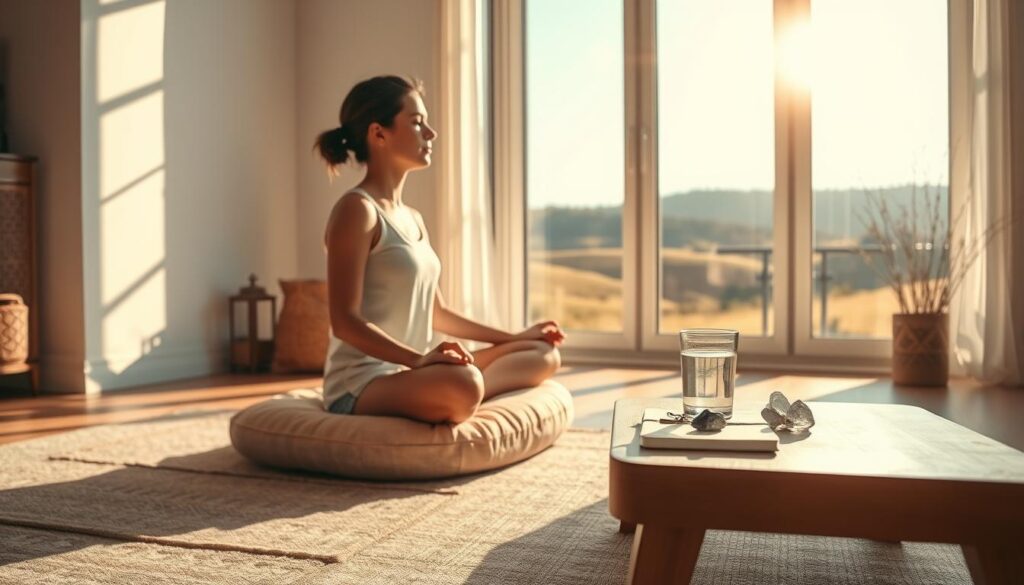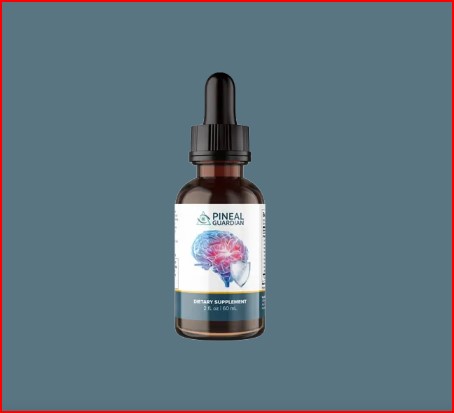How to Activate Pineal Gland and Experience Pineal Awakening

We have felt that quiet tug inside when morning light hits our face or when a deep breath steadies our mood. This small, honest nudge can lead us toward a clearer life and a gentler sense of inner guidance.
Here we introduce what the pineal gland is — a tiny, pinecone-shaped organ sitting deep within the brain that links sleep rhythms with a broader feeling of awareness and explain about how to activate pineal gland.
We will focus on building stability first so the power we find supports daily living. Our plan blends breath-led work, simple meditation, mindful light exposure, nourishing foods, and gentle movement.
We expect steady benefits like calmer sleep, clearer thinking, and a deeper connection with our inner life — not promises of instant change. We also note safety: pause and seek professional care if mood or sleep shifts become large concerns.
Key Takeaways
- We explain what the third eye is and where it sits within the brain.
- We prioritize stability before exploring deeper practices.
- We combine breath, meditation, light, nutrition, and sound for safe routines.
- We set realistic goals: better sleep, calmer nerves, and greater awareness.
- We recommend professional help if anxiety or depression worsen.
Understanding the Pineal Gland in the Brain and Why It Matters
We locate a tiny, pinecone-shaped organ deep inside the skull that quietly times our sleep and wake cycles. It sits in the epithalamus, tucked deep within the brain, and its form helped spark the third eye metaphor across many cultures.
Our third eye connection: location, role, and cultural meaning
The gland’s placement and shape linked it with the eye of inner sight and the agna chakra in yogic teaching. Traditions often protect the back-of-head spot, reflecting a long-held sense of sensitivity and symbolism.
Melatonin, circadian rhythm, and mood regulation
Biologically, it secretes melatonin, which times circadian rhythm and influences sleep quality. Morning light reaching our eyes signals the brain to suppress melatonin during the day and allow its rise at night.
- Practical outcome: steadier sleep-wake cycles support clearer mind and balanced mood.
- Foundations: regular sleep times and simple dietary support create favorable conditions for long-term health.
We now have a grounded understanding that blends science and tradition, setting the stage for safe, stability-first practices that follow.
The Present Moment Context: What Science and Spiritual Traditions Agree On
Where neuroscience and yogic physiology point toward rhythm, balance, and sensible care, we see a clear overlap.
Where modern neuroscience meets yogic physiology
Neuroscience highlights the role of circadian timing in sleep and mood. Yogic maps place the same region as the agna chakra, linked with perception and inner awareness.
Stability before ecstasy as a guiding principle
We follow a stability-first rule: build reliable sleep, calm attention, and a resilient nervous system before seeking intense peaks.
- Both lines agree: steady routines shape clearer consciousness and steadier mind.
- Safe, consistent practices — breath, mindfulness, gentle movement — create durable change.
- Chasing peak states can backfire; gradual progress preserves balance in daily life.
- We measure stability by regular sleep, steadier mood, clearer baseline attention, and fewer stress spikes.
We respect science for safety and tradition for meaning. Over time, simple checkpoints—weekly notes on sleep, stress, and attention—help us test progress in a practical, repeatable way.
How to Activate Pineal Gland: A Step-by-Step Practice
We set a clear, simple routine that fits daily life and aims for steady change. This short practice blends breath, mindful body scanning, and a gentle close so our system calms without forcing outcomes.
Preparing our space, posture, and intention
Dim lights, silence devices, and choose a comfortable seat. Set a one-line intention—steadiness, clarity, or compassionate awareness—so the mind has direction.
Breath-led activation with mindful body scanning
- Begin slow nasal inhalations, feeling cool air at the nostrils and lengthening each breath.
- Scan the body from feet to head, briefly tensing major muscle groups and releasing on the exhale.
- Let attention rest gently between the eyebrows, noticing sensations without strain.
Closing and grounding to stabilize mood and energy
Put one hand on the belly and the other on the heart. Feel breath shifts and note any calm or tension.
Ground by noticing contact points with the chair or floor, open eyes slowly, and journal one sentence about the session.
| Step | Action | Timing |
|---|---|---|
| Prepare | Dim lights, seat support, set intention | 1–2 minutes |
| Breath & Scan | Slow nasal inhale, tense-release body scan | 3–8 minutes |
| Third Eye Attention | Soft focus between eyebrows, no force | 1–2 minutes |
| Close & Ground | Hands on heart/belly, journal, orient senses | 1–2 minutes |
Breathwork and Muscle Tension-Release for Sleep and Calm</H2::
Our breath is a simple way to calm the body. This routine uses slow breathing and muscle release. It’s great before meditation or bedtime.
Slow nasal inhalation to soothe the nervous system
We inhale gently through the nose, lengthening the exhale. This helps us relax and sleep better. It also lowers stress and anxiety.
Reset the body, engage, tense, and gradually let go.
Gently tense major muscle groups for a short count, then ease out slowly on the exhale. This signals safety and reduces stress.
Repeating the sequence to deepen relaxation
Repeat the inhale-tense-exhale-release cycle three to five times. We track warmth, heaviness, and quieting of thought as a mindfulness anchor.
- Keep posture neutral—reclined or seated—and avoid breath holds.
- Pair with a consistent bedtime routine and low evening light to help melatonin rise.
- Note our experiences in a simple log: time practiced, anxiety levels, and sleep onset.
- If tension spikes or dizziness occurs, ease up or pause; consult a professional if insomnia or anxiety persist.
Third Eye Meditation to Cultivate Awareness and Intuition
In this short practice, we invite simple vision and soft breath at the inner focal point of the forehead. Third eye meditation blends a gentle image with calm counting and steady attention. The aim is clearer perception and a quieter inner voice.
Focusing between the eyebrows with visualization
We sit comfortably and rest attention at the point between the brows. Invite a soft dot of light or a steady glow without straining the eye. Optionally use a count—inhale four, exhale six—to steady the breath while the image stays effortless.
Balancing mindfulness with gentle concentration
We balance open awareness with light concentration. When distractions come, label them and go back to focus. Start with short sessions, 5 to 10 minutes, and increase as you get more comfortable.
- Instead of a demand, let intuition emerge as a quiet sense.
- Soften if brow pressure appears; switch to breath-only awareness when needed.
- Close by widening awareness to breath, heart, and surroundings and journal any emerging themes as notes for daily life.
Light, Sleep, and Melatonin: Optimizing Our Daily Rhythm
Simple changes in daily light exposure have large effects on sleep timing and daytime focus. We get morning sunlight within an hour of waking to anchor circadian time and lift daytime alertness.
Evening dimness matters. We dim lights and minimize screens 60–90 minutes before bed so melatonin can rise and our nights feel more restful. Tryptophan-rich evening snacks may gently support the pathways linked with nightly rhythms.
Consistency is the foundation. We keep steady sleep and wake times, including weekends, to stabilize the system and support the pineal gland rhythm. Small shifts—an earlier sunset walk or blackout curtains—add up over weeks.
- Cool the room, finish intense exercise earlier, and limit late alcohol or heavy meals.
- Pair light hygiene with calming routines like breathwork, reading, or gentle stretches.
- Track simple metrics—sleep latency, wake-ups, and morning mood—to see benefits for our mind and overall health.
By tending light and routine, we give the pineal gland and the whole sleep system steady cues that improve sleep and daily life.
Dietary Support and Gentle Detox Considerations
A gentle food-first approach gives practical support for sleep regulation and mental clarity. We pair steady meals with hydration and modest detox choices so our routines feel sustainable.
Tryptophan-rich and melatonin-supportive foods
We add tryptophan-containing items—turkey, eggs, dairy, nuts, and seeds—into daytime meals. This supports pathways linked with nightly melatonin rise.
Evening snacks like cherries and bananas can be helpful as part of a balanced approach. We avoid relying on any single ingredient and keep portions moderate.
Hydration and simple detox practices
Hydration matters for steady energy and natural clearance in the body. We drink water across the day and favor whole foods over processed options.
“Consistent diet patterns, paired with gentle hydration, tend to give the most reliable gains for sleep and mood.”
- Practical tips: add leafy greens and fiber, keep snacks simple, and align meals with our meditation and yoga practices.
- Consider basic checks on fluoride in local water and consult dental or public health guidance before making changes.
- Avoid extreme detox protocols; choose gradual shifts that respect the body’s pace.
| Focus | Examples | When |
|---|---|---|
| Tryptophan foods | Turkey, eggs, dairy, nuts, seeds | Daytime meals |
| Evening support | Cherries, bananas, small snack | 60–90 minutes before bed |
| Hydration & detox | Water, fiber, leafy greens | All day |
| Safety note | Consult local reports and providers on water and dental care | Before major changes |
We remember: diet complements our breathwork, light routines, and meditation practices. Small, steady changes bring clearer sleep, calmer mood, and firmer awareness without dramatic promises.
Yoga for the Pineal Gland and Agna Chakra
A short, gentle yoga sequence readies our body and attention for quiet inner focus. We use movement and rest to calm the nervous system. This prepares us for seated practice aimed at the agna chakra and the third eye.
Child’s Pose to calm the mind
Child’s Pose
Begin in Balasana and lengthen the back body. We soften the breath and let the jaw relax.
This posture helps quiet the mind. It gives gentle pressure around the forehead area, supporting relaxed third eye attention.
Downward-Facing Dog
Move into Adho Mukha Svanasana to invite mild inversion and increased head circulation. We keep smooth, relaxed breathing and avoid strain.
This pose can invigorate blood flow toward the head. The spine stays long and the shoulders open.
Corpse Pose for integration and awareness
Finish in Savasana for full integration. We rest the body and let shifts in awareness settle without pushing.
Hold each pose one to three minutes. Include gentle neck and shoulder mobilizations if tension appears. Use props—bolsters or blocks—so our body feels safe and supported.
- Synchronize breath with movement as a moving meditation.
- Keep cues simple: long spine, soft jaw, steady exhales.
- End with brief seated stilness, bring attention to the area between the eyebrows, then widen to the whole body.
Sound, Vibration, and Complementary Tools
Listening closely to tuned frequencies can offer a calm background for focused awareness. We treat sound and objects as supportive aids, not shortcuts to change.
Working with 432 Hz, 528 Hz, and 963 Hz
We explore soundscapes at 432 Hz, 528 Hz, and 963 Hz as gentle ambient backdrops for meditation. Keep volume low so vibration supports attention without overwhelming it.
Using crystals like amethyst and quartz in practice
We place amethyst or quartz nearby as symbolic anchors for third eye focus. Effects are mostly anecdotal; we note experiences without assuming universal outcomes.
- Try 10–20 minute sessions and record subjective experiences in a short log.
- Utilize tools to complement core practices and combine sound, breath, and posture.
- Observe how our system responds across days and choose what reliably deepens a deeper connection.
- Rotate tools to avoid dependence and finish by grounding—feel feet and listen to room sounds.
“Use tools as gentle supports; the main work remains steady breath, posture, and attention.”
Recognizing Signs of Activation Versus Imbalance
We learn to read subtle changes in mood and dreaming as practical feedback from our practice. These signals help us judge whether growth is steady or if we need to step back.
Intuition, vivid dreams, and mental clarity
Positive signs include a gentle rise in intuition, more vivid yet restful dreams, and moments of clear thinking that guide better choices. Physical sensations at the forehead may appear, but they are usually mild and brief.
Mood shifts, sleep changes, and when to pause
Warning signs can include edgy mood, poor sleep, fixation on odd experiences, or a sense of overwhelm. Sadhguru and other teachers note that tipping the wrong side can feel emotionally toxic, which is why we favor stability-first practice.
- Keep daytime function—work, relationships, self-care—as our main gauge of health.
- Soften practice if brow sensations intensify; return to breath and body orientation to protect the system.
- Journal weekly to sort signal from noise and track lasting clarity versus fleeting sensation.
- Add calming supports—long exhales, restorative yoga, nature walks—when activation feels strong.
- Seek professional help if anxiety or depression persist or if sleep worsens despite changes.
Stability First: Safeguards for Mental and Emotional Health
Our practice starts with small, reliable steps to protect mental and emotional balance. We value steady routines that support overall health. These routines help reduce sudden mood or energy shifts.
Why we build foundations before seeking ecstasy
Yogic teachings warn that chasing intense states can disrupt the nervous system. This can increase anxiety or mood swings. Consistent sleep, short sessions, and gradual progress are our simple guidelines.
When to consult mental health and medical professionals
Meditation and mindfulness are useful practices, but they do not replace evidence-based care. If anxiety rises, depression deepens, or daily functioning slips, we reach out to a primary care provider, therapist, or psychiatrist.
“When symptoms persist, licensed care and assessment provide safety and clearer options.”
- Reaffirm stability-first: protect mind and system while exploring awareness.
- Watch for red flags and simplify practice early.
- Keep trusted contacts and consider community support and accountability.
- Recognize advanced treatments exist—seek licensed providers for persistent depression or treatment-resistant cases.
| Concern | Sign | Suggested action |
|---|---|---|
| Anxiety | Rising nervousness, sleep disruption | Shorten sessions; consult therapist |
| Depression | Persistent low mood, loss of function | Contact primary care; explore evidence-based options |
| System overload | Fixation, irritability, poor concentration | Rest days, restorative practices, professional support |
Building Our Daily Routine for Pineal Health
A few steady habits each day give our rhythms a firm, reliable base. We design a day that supports health, sleep, and clear attention. We use light, movement, and consistent timing.
Morning light and mindful movement
Anchor mornings with 5–10 minutes outside. Morning sunlight helps set circadian time and boosts daytime alertness.
Pair light with a brief mindful movement or yoga sequence. Even five minutes of gentle stretches wakes the system without strain.

Midday nourishment and stress regulation
We space meals predictably and choose balanced nutrition to keep energy steady through the afternoon.
Every few hours, take a micro-break: two minutes of mindful breathing to lower stress and restore clarity.
Evening wind-down, breathwork, and sleep hygiene
Schedule a 20–45 minute evening routine: dim lights, a digital curfew, calming tea, and low-stimulation activities.
Practice the inhale-tense-release sequence or a short meditation for 5–10 minutes before bed. These steps cue rest and ease the transition into sleep.
- Keep bed and wake times steady, matching our natural chronotype when possible.
- Limit late naps and use the bed only for sleep to strengthen mental association.
- When travel or busy days happen, protect at least one anchor—morning light or the bedtime routine.
- Review the routine monthly and adjust practices so they fit our life and remain realistic.
“Consistency in light exposure and timing is the quiet work that yields lasting rhythm and calmer days.”
| Time | Action | Purpose |
|---|---|---|
| Morning | 5–10 min outdoor light + short yoga | Set circadian time, increase alertness |
| Midday | Scheduled meals + 2-min breathing breaks | Stabilize energy, reduce stress |
| Evening | 20–45 min wind-down + 5–10 min breathwork | Signal sleep readiness, improve sleep quality |
Conclusion
We end with an invitation to choose simple, consistent steps that deepen our daily awareness. Gentle routines like light work, regular sleep, and breathwork support the pineal gland and nervous system.
We keep stability before ecstasy as our main rule. Notice shifts in intuition, clarity, and third eye awareness as slow trends, not urgent signs.
Tools like sound or crystals are optional complements, not replacements for core practice. Stay curious, track experiences, and respect limits. If sleep or mood worsen, seek professional care.
We step forward with small, steady actions that improve our sense of connection and life, and we do so with humility, care, and intention.
FAQ
Where in our brains is the pineal structure and what does it look like?
Near the thalamus, in the center of the brain, is the pineal gland, a small, conical organ. It connects light and our daily rhythms through melatonin. This hormone helps us sleep, manage our mood, and follow seasonal changes.
Why does the third eye idea appear in both science and spiritual traditions?
Both science and spirituality see the third eye as an inner sensory hub. Science talks about its role in hormones and our body’s clock. Spirituality views it as a center for subtle perception and focus, located between the eyebrows. Together, they offer a way to improve our presence.
What immediate steps prepare our body and mind before a focused practice?
To prepare, find a calm space and sit upright but relaxed. Set a brief intention. Soft lighting, steady breathing, and muscle relaxation help us focus and reduce anxiety.
Which breathing pattern supports restful nervous system regulation?
Use nasal breathing to inhale slowly and exhale slowly. This calms the parasympathetic system. Pair it with body scans to release tension and improve sleep and focus.
How do we work with third eye meditation without forcing experiences?
Focus gently on the third eye area with a soft visualization or light. Balance awareness and concentration. Avoid forcing it, as patience leads to clearer perception.
What role does light exposure play in supporting natural melatonin cycles?
Morning light helps set our body’s clock and keeps us alert. Evenings should have dim, warm light to help melatonin production. This supports better sleep and mental clarity.
Which foods and simple detox habits support healthy neurotransmitter balance?
Eat foods high in tryptophan, magnesium, and vitamin B6 like turkey and leafy greens. Stay hydrated and avoid too much processed food and fluoride. This helps keep your mind clear.
What yoga postures help calm the mind and encourage head circulation?
Child’s Pose calms the nervous system. The Downward-Facing Dog increases blood flow to the head and upper body. Savasana (Corpse Pose) helps integrate breath and awareness for calm.
Are sound frequencies and crystals helpful during attentive practice?
Many find specific sounds and crystals helpful for focus and relaxation. Use them as aids, but remember, everyone responds differently.
What early signs might indicate increasing inner sensitivity or imbalance?
Look for heightened intuition, vivid dreams, and clearer focus. Mood and sleep changes can also signal shifts. If you feel overwhelmed or experience sleep issues, take a break and seek support.
How do we keep practices safe and balanced for mental health?
Establish a steady routine that includes regular sleeping, stress management, and daily habits. If practices cause anxiety or other issues, seek help from professionals.
What daily routine supports long-term inner balance and perception?
Establish a daily structure: morning light and movement, midday breaks, and evening calm. Consistent sleep times help maintain rhythm and clarity.




Post Comment